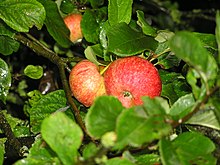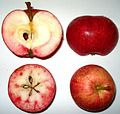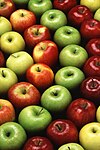
Pears are fruits produced and consumed around the world, growing on a tree and harvested in the Northern Hemisphere in late summer into October. The pear tree and shrub are a species of genus Pyrus, in the family Rosaceae, bearing the pomaceous fruit of the same name. Several species of pears are valued for their edible fruit and juices, while others are cultivated as trees.

The peach is a deciduous tree first domesticated and cultivated in Zhejiang province of Eastern China. It bears edible juicy fruits with various characteristics, most called peaches and others, nectarines.

The cashew tree is a tropical evergreen tree that produces the cashew seed and the cashew apple accessory fruit. The tree can grow as tall as 14 metres, but the dwarf cultivars, growing up to 6 m (20 ft), prove more profitable, with earlier maturity and greater yields. The cashew seed is commonly considered a snack nut eaten on its own, used in recipes, or processed into cashew cheese or cashew butter. Like the tree, the nut is often simply called a cashew. Cashew allergies are triggered by the proteins found in tree nuts, and cooking often does not remove or change these proteins.

Carambola, also known as star fruit, is the fruit of Averrhoa carambola, a species of tree native to tropical Southeast Asia. The mildly poisonous fruit is commonly consumed in parts of Brazil, Southeast Asia, South Asia, the South Pacific, Micronesia, parts of East Asia, the United States, and the Caribbean and contains the neurotoxin caramboxin. The tree is cultivated throughout tropical areas of the world.

Malus is a genus of about 30–55 species of small deciduous trees or shrubs in the family Rosaceae, including the domesticated orchard apple, crab apples, wild apples, and rainberries.

Pollination of fruit trees is required to produce seeds with surrounding fruit. It is the process of moving pollen from the anther to the stigma, either in the same flower or in another flower. Some tree species, including many fruit trees, do not produce fruit from self-pollination, so pollinizer trees are planted in orchards.
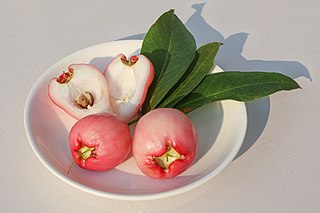
Syzygium samarangense is a species of flowering plant in the family Myrtaceae, native to an area that includes the Greater Sunda Islands, Malay Peninsula and the Andaman and Nicobar Islands, but introduced in prehistoric times to a wider area and now widely cultivated in the tropics. Common names in English include wax apple, Java apple, Semarang rose-apple and wax jambu.

Red Delicious is a type of apple with a red exterior and sweet taste that was first recognized in Madison County, Iowa, in 1872. Today, the name Red Delicious comprises more than 50 cultivars. From 1968 to 2018, it was the most produced cultivar in the United States. Gala became the most produced after that.

Pouteria sapota, the mamey sapote, is a species of tree native to Mexico and Central America. The tree is also cultivated in the Caribbean. Its fruit is eaten in many Latin American countries. The fruit is made into foods such as milkshakes and ice cream.
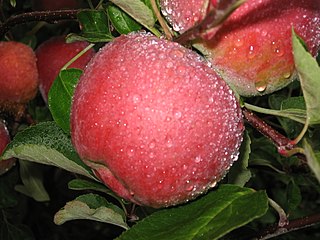
'Macoun' apples are a cross between the 'McIntosh' and 'Jersey Black' cultivars. The Macoun was developed at the New York State Agricultural Experiment Station in Geneva, by Richard Wellington. It was first introduced in 1923, and is an eating apple. This apple is excellent for making European style apple pies because it doesn't break down during cooking and remains firm. Macouns are also very popular at roadside stands and pick-your-own farms. Availability is generally October through November. Sugar 13%, acid 6g/litre, vitamin C 4mg/100g.

Diospyros kaki, the Oriental persimmon, Chinese persimmon, Japanese persimmon or kaki persimmon, is the most widely cultivated species of the genus Diospyros. Although its first botanical description was not published until 1780, D. kaki is among the oldest cultivated plants, having been in use in China for more than 2000 years.

An apple is an edible fruit produced by an apple tree. Apple trees are cultivated worldwide and are the most widely grown species in the genus Malus. The tree originated in Central Asia, where its wild ancestor, Malus sieversii, is still found today. Apples have been grown for thousands of years in Asia and Europe and were brought to North America by European colonists. Apples have religious and mythological significance in many cultures, including Norse, Greek, and European Christian tradition.

'Discovery' is an early season dessert apple cultivar. One of its parents was the 'Worcester Pearmain', with the pollinator thought to possibly be 'Beauty of Bath'.

The fig is the edible fruit of Ficus carica, a species of small tree in the flowering plant family Moraceae. Native to the Mediterranean and western Asia, it has been cultivated since ancient times and is now widely grown throughout the world, both for its fruit and as an ornamental plant. Ficus carica is the type species of the genus Ficus, containing over 800 tropical and subtropical plant species.

The 'Laxton's Superb' is an apple cultivar that was developed in England in 1897. It is a cross breed between Cellini and 'Cox's Orange Pippin' and is not a cross between Wyken Pippin and Cox Orange Pippin. It is a British apple with a green color and a dull red flush. It is a firm-textured dessert apple. The fruit is well known for its sweet and aromatic taste which is likened to the parent species it is derived from, the 'Cox's Orange Pippin'. Density 0,82 g/cc, sugar 14,0%, acid 7,4 g/litre. Vitamin C 9mg/100g.

Pristine apple is a hybrid cultivar of 'Co Op 10' x 'Camuzat' domesticated apples, which are descendants of the 'McIntosh' apple and the 'Starking Delicious'. This cultivar was developed and patented in the United States by the PRI disease resistant apple breeding program, in Indiana, United States in 1994, for its resistance to apple scab. It is susceptible to cedar-apple rust.

'Akane', also known as 'Tokyo Rose', 'Tohoku No.3' and 'Prime Red', is a Japanese cultivar of domesticated apple, that according to Orange Pippin is one of the best early season apples.

Åkerö, also called Akero or Okera, is an old apple cultivar of presumed Swedish origin, but possibly introduced from the Netherlands. It is a dessert apple with an aromatic flavor.

Dumelow's Seedling is a cultivar of domesticated apple that originated at Shackerstone in Leicestershire where it was grown by Richard Dumeller in 1800. It is known by many other names including 'Dumelow's Crab', 'Wellington', 'Doncklaer', 'Beauty', and 'Belle de Vennes'. The fruit is not ready for harvest until October, being one of the last of the season, and keeps well into the next year. Though inferior for use as a dessert apple it cooks well and in early-20th century England was one of the most valuable varieties of cooking apple.
Ellis Bitter, also called Ellis's Bitter or Ellis's Bitter-Sweet, is an English cider apple originating in Devon, but now widely planted across the west of England.
